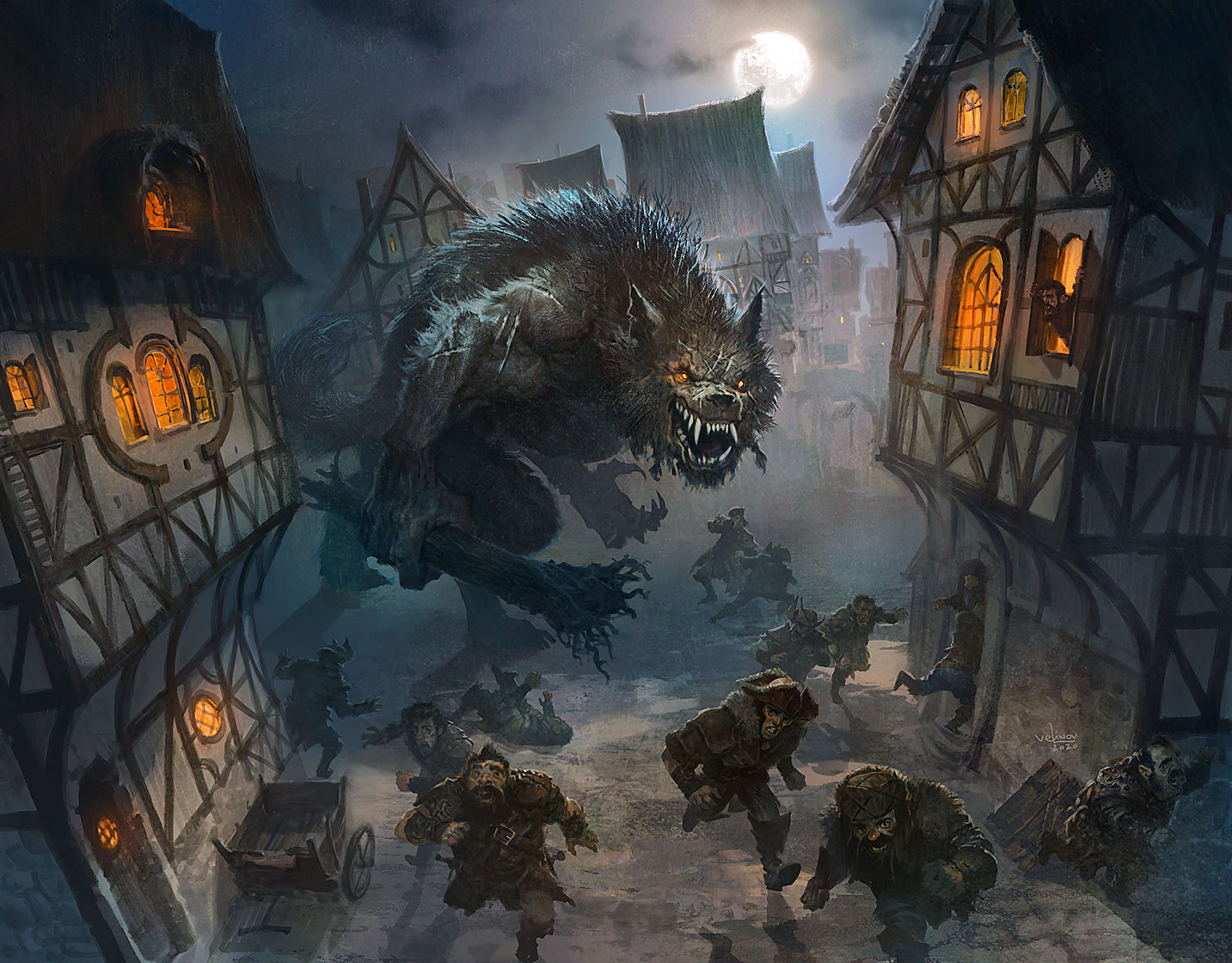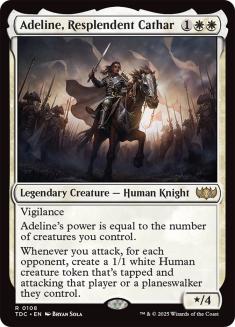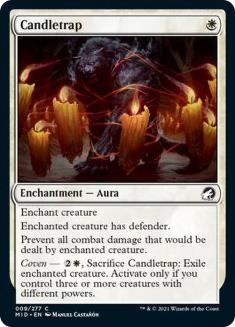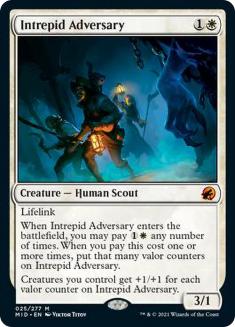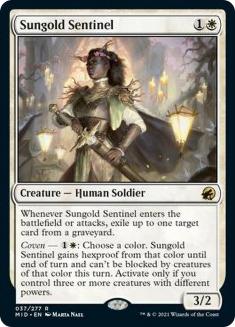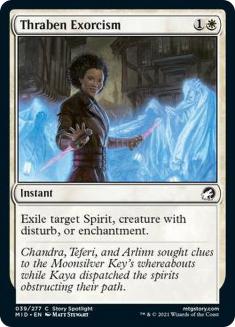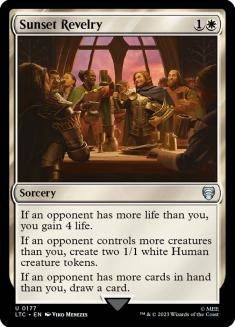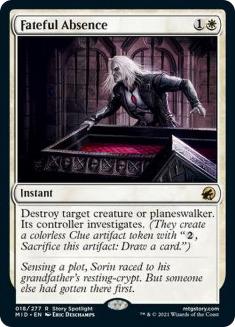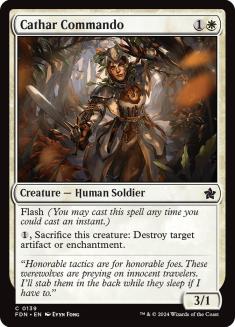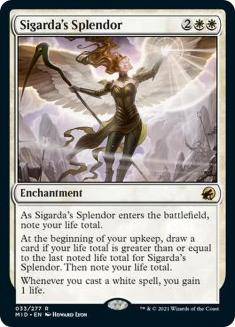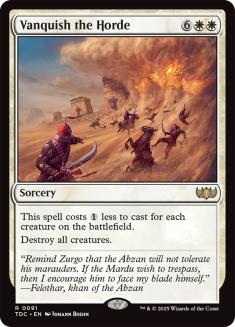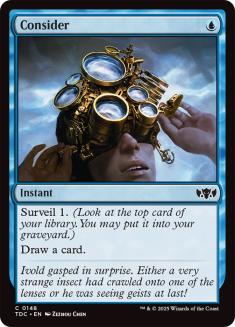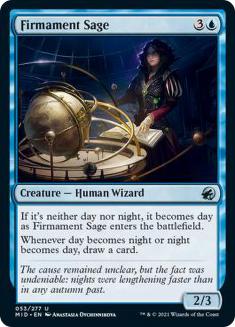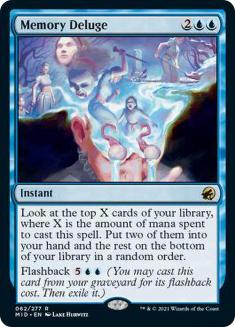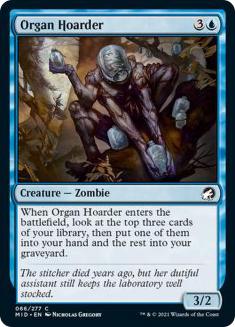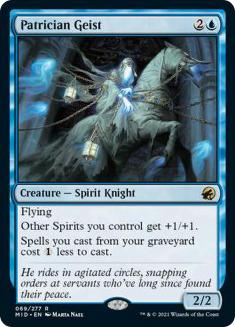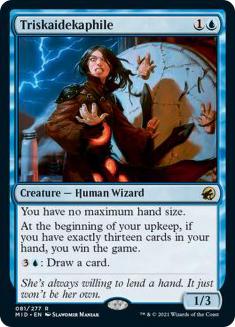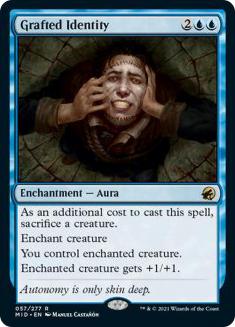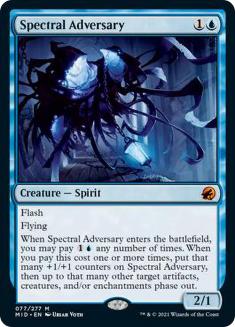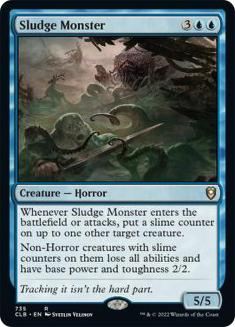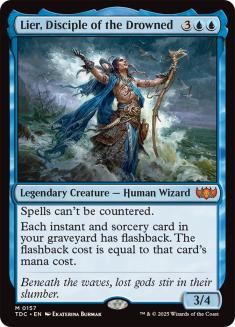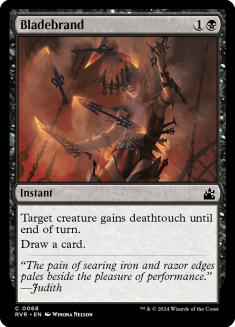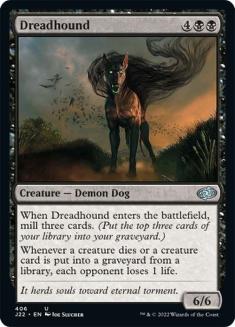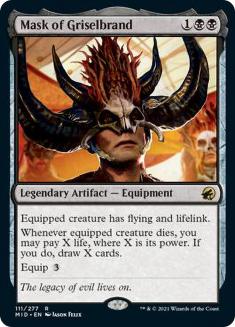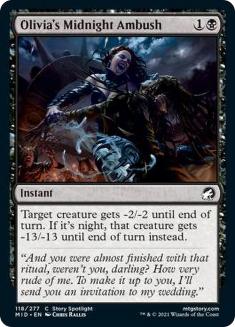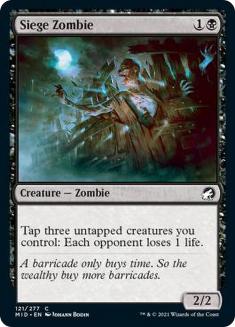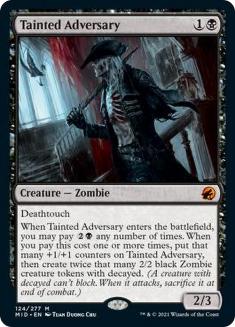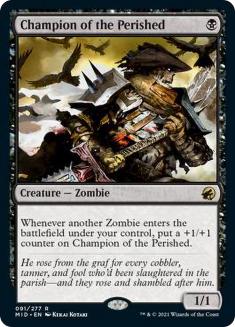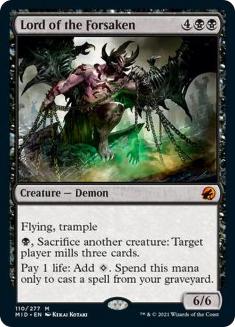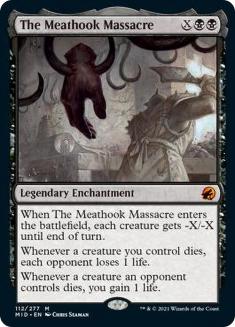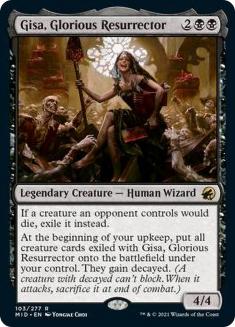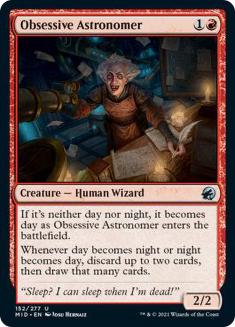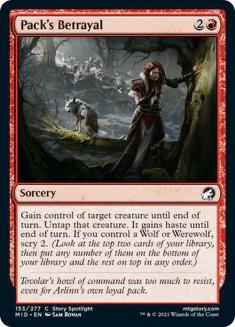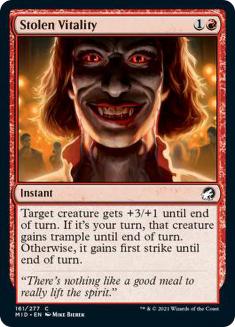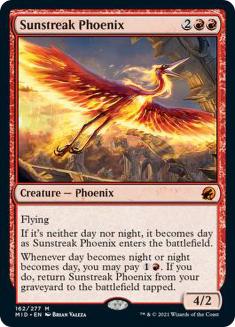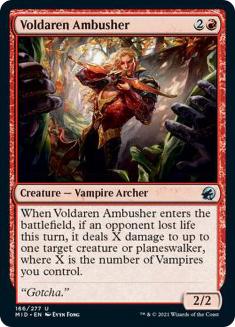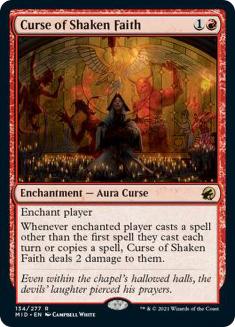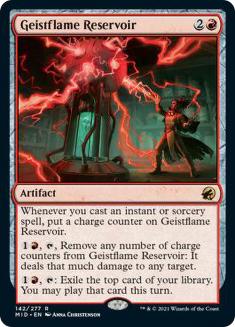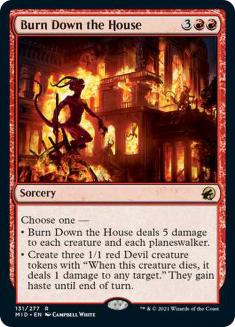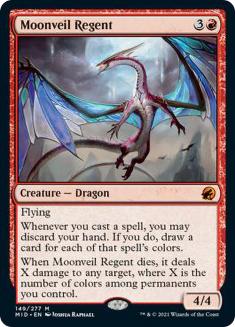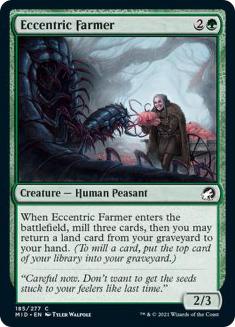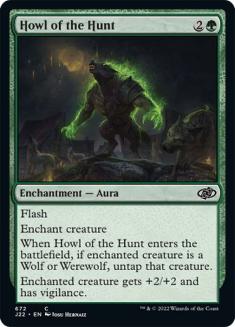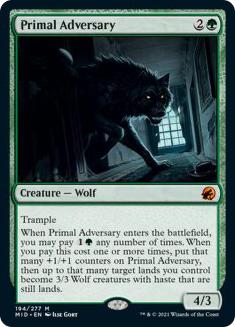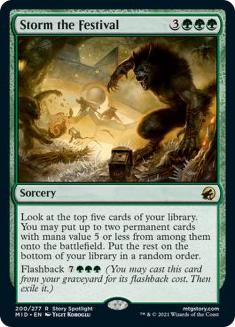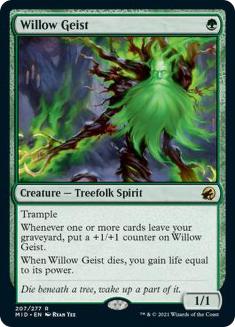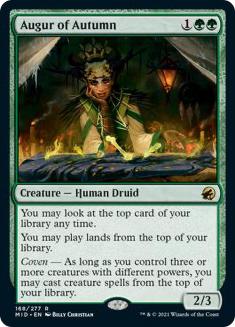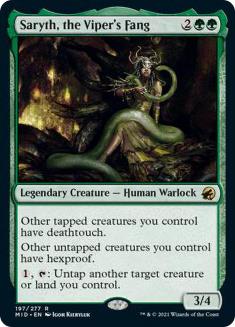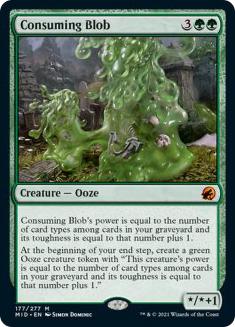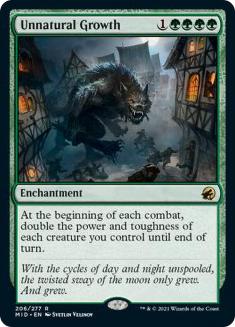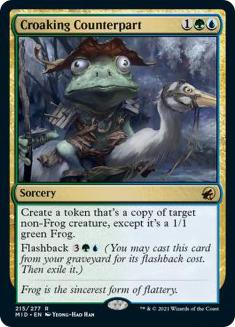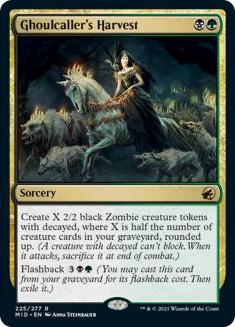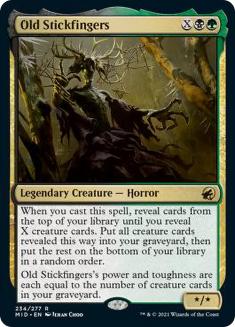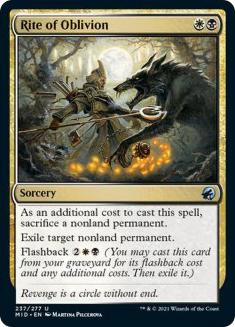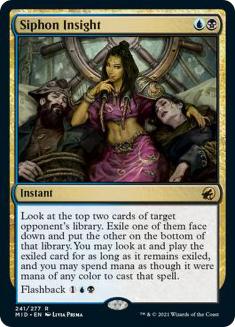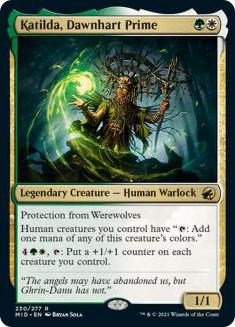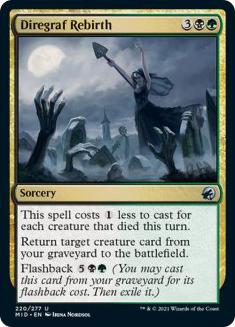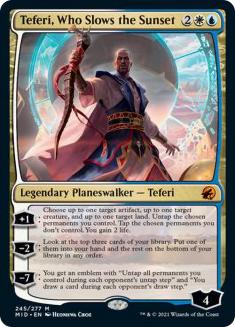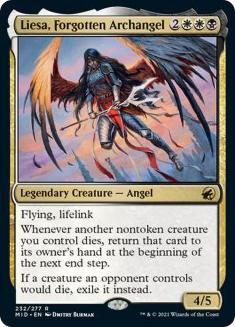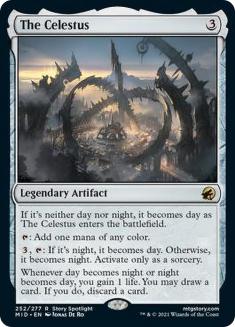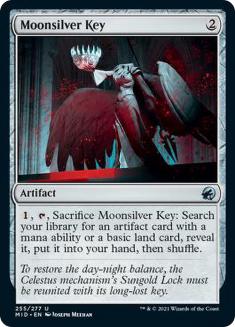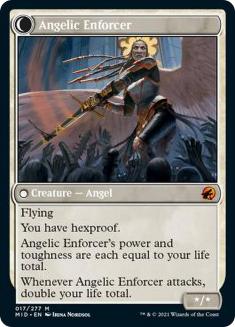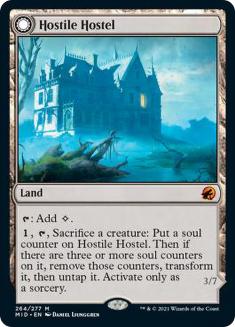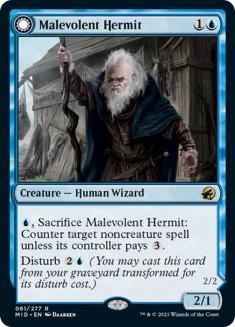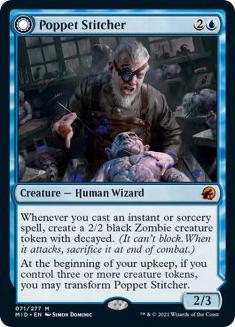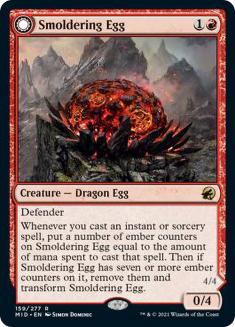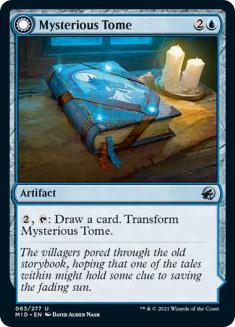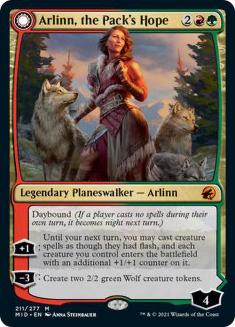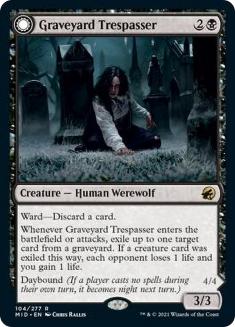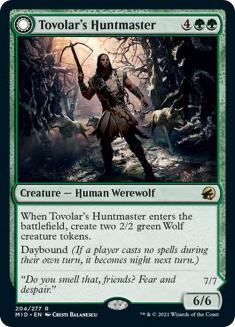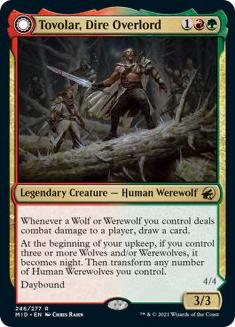Whether it’s day or night, wandering the world of Innistrad: Midnight Hunt is fraught with dangers—for your opponents. With the entire set having dropped, it’s time to explore what the creepy towns and spooky wildernesses hold for sliding into your existing Commander decks or inspiring new ones.
I’ll break this review down by color, with multicolor, artifacts and lands, and double-faced cards each as their own sections. I’ll make some brief notes on the color as a whole, register some honorable mentions, and then pick a Top Five for more detailed discussion. Remember that this is a Commander-only review; there are some cards in the set that will be Limited stars but we won’t see much of. Also, my comments are in the context of the format’s target demographic and broadest part of the player base. Highest-powered mileage may differ.
The new mechanic that most intrigues me is the multikicker-esque one found on Bloodthirsty Adversary, Intrepid Adversary, Primal Adversary, Spectral Adversary, and Tainted Adversary. What’s compelling about it is that you don’t have to invest the mana up front, only to get it countered. They’re all two mana, save Primal Adversary, which is three. You start off with a small investment. Then, when they enter the battlefield, you can choose how many times you pay the cost. They’re all situationally interesting cards which require a fair amount of mana to do a great deal with, which keeps them in check. A neat trivia note is that these five represent half of the cards in all of Magic that use the character string “any number of times.”
We also have new double-faced cards, enough to warrant their own section. Some of them have two new designations, daybound and nightbound. The rules are pretty simple. It’s neither day nor night when the game starts, but when a permanent with daybound enters the battlefield, it becomes day. Once it’s day, if the previous turn’s active player didn’t cast any spells, it becomes night. When it’s night and a player casts at least two spells on their own turn, we go back to day. There are also spells and abilities which can make the change happen and a few that trigger on the change from day to night or night to day. What’s important to note is that the “bound” cards can’t transform in any other way (like with Moonmist).
We have the new version of transforming, disturb, which lets you cast the card from your graveyard for its disturb cost, usually an upgraded, beyond-the-grave version that’s thematically tied to the front face. The front face has the day marker and the back night. The other part is that if the card is on the stack or on the battlefield in its back face and would be put in the graveyard (so if it’s countered or dies), it’ll be exiled instead. It’s not a leaves-the-battlefield trigger, so you can bounce it back to your hand, where it will exist as its front face again (see Rule 712 for all the hairy details on DFCs).
I’m a fan of both the flavor and mechanics of disturb. For one, it’s really immersive, gripping us with the flavor in Innistrad. From a game play perspective, it solves the problem of having too many expensive cards in your hand early in the game. The day face is inexpensive, the night kind of spendy. One card gives you flexibility to play both an early- and late-game card while expending only one deck slot. All the mechanics done, let’s get onto the cards.
White
White is pretty much doing what you expect it to do—buff some creatures, play some control, add some counters, make some tokens, and help you attack a little better. There’s nothing in the color that screams super-loud, but nearly everything is some version of solid.
Honorable Mention:
5. Sunset Revelry
There’s quite a bit going on here; none of it’s game-breaking, but it’ll cost you just two mana. The big part for me is that it replaces itself, so you can get your life, tokens, and continue on with your plan.
4. Fateful Absence
Instant speed removal (which can also hit planeswalkers) in white still means giving people something. I’d rather give them a Clue than a land, like with Path to Exile or life with Swords to Plowshares. Mana isn’t so tight that I can’t pay the extra {1}.
3. Cathar Commando
One that I expect will be very strong in Limited. I love the fact that a common makes an appearance on the Top 5. For three mana, you’re going to flash in Cathar Commando, block something huge, and then sacrifice it to Disenchant something. It also comes back with Sun Titan.
2. Sigarda’s Splendor
If you’re playing defensively and gaining life, you’ll be drawing lots of cards for free with Sigarda’s Splendor. It has some built-in help by gaining life whenever you cast a white spell, but I’m thinking in bigger terms. Note your total at the beginning of upkeep, then gain enough life through lifelink creatures and/or Wall of Reverence to not have to worry if you get some attacks back. A nice design that you have to do some work to get value out of.
1. Vanquish the Horde
A sort of Blasphemous Act variant, in many Commander games, this will end up being Day of Judgment for just {W}{W}. It’s not quite as much fun as Play of the Game, but it’s going to get the job done in very efficient fashion.
Blue
The counterspell and bounce options in blue are strong, to include the upgraded Unsummon, Fading Hope. Library manipulation is pretty standard and there’s some Zombie action as well. While there’s a good deal of flavor, besides the number one card, there’s not all that much to get excited about. Blue here seems to be filing a very utilitarian role.
Honorable Mention:
5. Triskaidekaphile
A narrow and unusual alternate win condition kind of hides the fact that you can draw cards without tapping Triskaidekaphile as it offers you an unlimited hand size. Its low mana cost means you might just sneak into a win on an early or middle turn.
4. Grafted Identity
I’m okay with the additional cost of sacrificing a creature when it’s something that I want to reanimate anyway in a black deck or just a Solemn Simulacrum in most decks. Like many of the set’s blue cards, it’s not splashy, but nicely functional.
3. Spectral Adversary
Phasing out creatures that are potential blockers is likely the most popular use of Spectral Adversary in Commander games. The closer the player is to your right, the longer they’ll go without them.
2. Sludge Monster
From a flavor perspective, I’d like this to be an Ooze, but I get why it’s not. Being able to neutralize some of the best creatures in the format—like Avacyn, Angel of Hope—will go a long way to enacting your Horror-laden plans. You’ll obviously want to blink it a few times for fuller value.
1. Lier, Disciple of the Drowned
This one’s a biggie and most of what you need to know is in that first sentence: Spells can’t be countered. That means that you can’t counter them, either, which might cause some anxiety for a good swath of blue players. The flashback part is likely to get you running through iterations with some kind of combo or storm deck, which you won’t have to worry about anyone disrupting. Cool card and I’m extremely happy that the uncounterability is symmetrical.
Black
The best of the best in black is extremely saucy. The color in general hits all the flavor notes that you want it to while offering up plenty of playable choices. It’s the strongest of the three colors so far, by quite a bit. Being an unapologetic student of the Humanities, the art on Rotten Reunion riffing on American Gothic does my heart a great deal of good.
Honorable Mention:
5. Tainted Adversary
I’m a sucker for creating Zombies. I already have two Zombie decks (Zombies of Tresserhorn and Gisa and Geralf Together Forever), and now I’m wondering if there are enough to build a third. It’s like my Karador, Ghost Chieftain obsession, only it doesn’t smell as nice.
4. Champion of the Perished
I wrote a fair amount about Champion of the Perished when we got some first looks at the previews. Nothing that I’ve seen since then has dampened my enthusiasm for this card. I cannot wait to have it be part of Patriarch’s Bidding.
3. Lord of the Forsaken
Flying trampler at 6/6 for six mana? I’m on board already. Add a sacrifice outlet that mills a target player for three and the grill is lit. Paying life to get colorless mana for casting spells out of the graveyard? Sizzling.
2. The Meathook Massacre
Certainly the most ear-catching card name in the set, The Meathook Massacre is creature removal, offensive weapon, and life total boost all in one. It’ll get expensive to sweep a board with bigger creatures on it, but combining it with Grave Pact or Dictate of Erebos will probably help pick off those larger remaining creatures. I can see playing it for just the two black mana in order to bring both of its triggered abilities online.
1. Gisa, Glorious Resurrector
The happiest grave robber in all of Innistrad is back and she’s rocking the cemetery. I could stop at just exiling my opponents’ cards that would die, but then Gisa hits the turbo-boosters and lets me have them once we get around to my upkeep. That will paint a huge target on her back, but the upside is worth the risk. When it works, having Gisa on the battlefield will indeed be Glorious.
Red
Red has gotten shafted for Commander before in sets, but this one kind of takes the cake. The good news is that it looks pretty solid for two-player formats. I’d rather green have taken it in the shorts, but that’s the way it goes sometimes. Finding “top” cards here was really stretching it. At least there are some decent multicolored cards in the set with red in them. The quality of red cards for Commander has significantly improved lately, so let’s hope this is just a bump in the road.
Honorable Mention:
5. Voldaren Ambusher
This one may end up being a nice finisher in your Vampire deck. You’ll be able to blink or reanimate Voldaren Ambusher to get more instances of the trigger. You could also just jam Lithoform Engine and/or Strionic Resonator.
4. Curse of Shaken Faith
Git wrekt, storm. With Curses making a comeback and having more options, this one’s stock rose.
3. Geistflame Reservoir
I think this one will end up kind of sneakily good. You won’t use the first activated ability until later in the game, but the second one will end up paying dividends. If you’ve built your deck with plenty of instants and sorceries, those cards will be ticking up your charge counter count. Goes nicely in a Prosper, Tome-Bound deck.
2. Burn Down the House
Hitting fliers and planeswalkers is a big deal with Burn Down the House. I suppose it might see some play in a Zurzoth, Chaos Rider deck to make the Devils, but I’m pretty sure this one will be all about the global damage. And you have to start singing Talking Heads when you play this.
1. Moonveil Regent
Whether you’re playing in a deck with black in order to fill up your graveyard or one in which you just cast lots of inexpensive spells, Moonveil Regent will get you there. The dies trigger isn’t likely to be much, but it’s a 4/4 flyer for four—only one of which is red—and a Dragon to boot. There are plenty of places it’ll slot in.
Green
Green seems to drift all over the place. It has its Wolf stuff and then kind of meanders through whatever else it’s doing. There’s kind of a +1/+1 counters thing going on (Contortionist Troupe, Defend the Celestus), but it mostly tries to capture the creepy-crawly aspect of the plane of Innistrad. Finding flavor over function is fine with me.
Honorable Mention:
5. Augur of Autumn
Playing lands off the top of your library is always good value, even if you’re not getting extra land drops like with Oracle of Mul Daya. The coven ability to also play creatures is a nice bonus.
4. Saryth, the Viper’s Fang
Saryth does many things. Your (tapped) attackers have deathtouch, which is doubly nice when they also have trample. Untapped creatures getting hexproof protects your utility creatures and those with vigilance. Untapping a creature or land can get into some crazytown, like when you untap Cabal Coffers or Nykthos, Shrine to Nyx. Saryth is the kind of card that’s neat to play around with.
3. Consuming Blob
The Blob that keeps on giving is a card you can cast at first opportunity, and then watch it and its offspring grow as you end up with more card types in your graveyard. The good news is that a Bojuka Bog will merely turn it into a 0/1 and at least not kill it.
2. Wrenn and Seven
In the previous article I link above, my intention was to write 250 words on Wrenn and Seven. I think I ended up with 800. I won’t reiterate those points. I’ll just say that the card is super-strong (and I still want to see Wrenn and One through Five). It’s going to be extremely popular in the format.
1. Unnatural Growth
How crazy is this card? Sure, four of the five mana to cast it have to be green, but after that you’re doubling up every single one of your creatures every combat! That’s on offense and defense, by the way. Most of your use of the card will be to smash face, but the backup buffed blockers is just fine, too. Unnatural Growth plus Xenagos, God of Revels makes quite a few creatures (especially commanders) into raw killers. Post-combat Fling becomes more life-threatening, Lord of Extinction is incalculably large, and so forth. This is a very Commander card.
Multicolor
The multicolor cards are where I expected the set to shine and I’m not disappointed. There’s flavor, good theming, utility, and power, with nothing being too close to generic good stuff. And then there’s all that Ladee Danger vibe on Siphon Insight. I’m a fan.
Honorable Mention:
5. Katilda, Dawnhart Prime
Humans are definitely a thing on Innistrad, and Katilda can get them there. When she’s around, every one of your creatures produces mana to get you to much bigger spells; when you have a bunch of them, they fuel her last activated ability to put a counter on each of your creatures. Protection from Werewolves is thematic and might even be relevant as the RC gets into our Innistrad Constructed League.
4. Diregraf Rebirth
It’s less likely that you’re going to have enough mana after a battlefield sweeper (unless you set off Oblivion Stone or Nevinyrral’s Disk, I suppose) to get loads of value from Diregraf Rebirth. I suspect it’s going to be from either sacrificing creatures to something, like Greater Good or Altar of Dementia, or a combat in which you intentionally sent creatures into harm’s way. If five creatures died, you can get back two of them for {B}{B}{G}{G}, which is cheap. The situational flexibility of the card, even if it’s limited to my own turn, makes me happy. It also thrills me that Gisa is out there dancing her happy dance.
3. Slogurk, the Overslime
For all the self-mill lovers and Dredge players out there, Slogurk is a treat. You can make it an offensive powerhouse pretty quickly or you can use those counters to bounce it back to your hand and fill it with land. If you’re getting extra land drops, things will get nutty pretty quickly. Note that if you blink Slogurk, that’ll also set off the leaves-the-battlefield trigger.
2. Teferi, Who Slows the Sunset
Another good Teferi. Just using the +1 ability to tap and untap things has so many possibilities that you’ll have to take a good look at the battlefield state to know where you will help yourself the most. The first time I looked at the card, I got so lost in the possibilities, I forgot to look at the other two abilities. The -2 doesn’t thrill me, but the –7 to get a Seedborn Muse effect and a card draw? That’s just patently absurd. Don’t believe anyone who says you should let them get the emblem and they’ll use it “fairly.”
1. Liesa, Forgotten Archangel
Just whoa. Liesa staples together two extremely strong triggered abilities onto a 4/5 flying, lifelink body for just five mana. There are plenty of ways to build around her as a commander that can leverage either or both of her triggered abilities and you’re not pushed in a particular direction. My initial thought is having my own creatures with good enters-the-battlefield triggers that kill other creatures, like Bone Shredder and Big Game Hunter. With Bone Shredder, you just don’t pay the echo—then there it is, back in your hand at the beginning of the next end step (it’d be a little busted otherwise). I haven’t given too much thought to what other cards might be in the environment, but Liesa is my initial thought for building the aforementioned Innistrad Constructed deck. The card is sweet without being overpowered.
Artifacts and Lands
There are obviously too few to pick a top number of anything. I’ll actually start with the lands, which I think we’re calling “slow” lands: Deserted Beach, Haunted Ridge, Overgrown Farmland, Rockfall Vale, and Shipwreck Marsh. They’re allied two-color lands that enter the battlefield tapped unless you two or more other lands. Seems fine and fair. Unless you’re playing in a super-fast environment in which you absolutely must make a Turn 1 play, they’re nice budget options and should see lots of play.
The narrative wheel around which the Innistrad: Midnight Hunt story revolves, The Celestus gets us flipping between day and night. It’s another three-mana rock with an interesting ability, a trend that our friends in Studio X have been hitting it out of the park on recently (see Strixhaven Stadium and Dungeon Map). Most of the time, your activation of The Celestus will trigger the looting ability, but there are plenty of other playable cards that take advantage of the day/night mechanic. I’m very fond of this card.
The strength of what you tutor for is going to scale based on how much mana you have available and what the game state is. Even though I’m not the biggest fan of tutors in Commander, this is good design. Sometimes you’ll get Sol Ring. Sometimes you’ll get Gilded Lotus or go crazy for Chromatic Orrery. Maybe Krark-Clan Ironworks. Maybe even Strixhaven Stadium.
Double-Faced Cards
The real show-pieces of the set. I knew going in that it would be hard to make some picks here. It was a little difficult to evaluate the cards with disturb alongside the daybound/nightbound ones; you’ll see the latter won out by a large margin despite the fact that I really love the disturb mechanic on a thematic level.
Honorable Mention:
5. Mysterious Tome
This is just such clever design that it had to go on my list, even if it’s not the most powerful. Drawing a card for two mana is good. The problem is that after you open the Mysterious Tome, it becomes Chilling Chronicle. If you don’t have a way to untap it, you still have to wait until next turn to use it, transforming it back. A little Voltaic Key action will keep things moving along.
4. Arlinn, the Pack’s Hope
Creature spells having flash is very good. There are surprise blocks (which keep Arlinn alive), you keep mana up for other spells, and your creatures aren’t around if someone sweeps the battlefield. I might be playing Arlinn just for that ability. If it happens to transform, the mana ability is a good boost since it also plusses up Arlinn’s loyalty, making her tougher to kill. Alternately, a big, tramply, indestructible Werewolf isn’t so bad, either.
3. Graveyard Trespasser
The graveyard hate is strong in Innistrad: Midnight Hunt and Graveyard Trespasser is a big part of that. Exiling cards both when it enters the battlefield and attacks, it’ll whittle away life totals too (for all your opponents, not just the player targeted). Transformed into Graveyard Glutton, you get two cards each time.
2. Tovolar’s Huntmaster
It’s not quite Grave Titan for Wolf creatures until it transforms into Tovolar’s Packleader. Then you’re going to want to have Rule of Law online, because you don’t want it transforming back. The Packleader is 7/7, gets the Wolfs when it attacks, and can also have a Wolf or Werewolf of yours fight a creature you don’t control.
1. Tovolar, Dire Overlord
Finally the Werewolf commander that we’ve wanted. You get card draw from combat damage, something that Gruul isn’t all that great with. You’ll be able to keep your hand pretty full since you’ll be running an aggressive deck. Once you transform to Tovolar, the Midnight Scourge, you have a Kessig Wolf Run-like ability that you can use on more than one creature (since it doesn’t tap). Tovolar can also target himself with the ability, making commander damage kills more likely.
Innistrad: Midnight Hunt is a set chock-full of excellent cards to play in Commander. The designers have continued to hit the notes from Strixhaven and Adventures in the Forgotten Realms, making cards that are thought-provoking without being just generically good. They’ve also perfectly captured the setting’s gothic horror flavor, which will no doubt make this a resonant set with the fan base.
I’m more than excited for three things. First, the RC is going to use Innistrad: Midnight Hunt commanders to run our Innistrad Constructed League. Second, I’m going to jam quite a few of these cards into my existing deck suite (which you’ll see next time). Finally, there are a few legendary creatures in this set that are simply calling my name, so look for some saucy new builds in the near future.
Visit my Decklist Database to see my Signature Decks, the Chromatic Project, and more!

